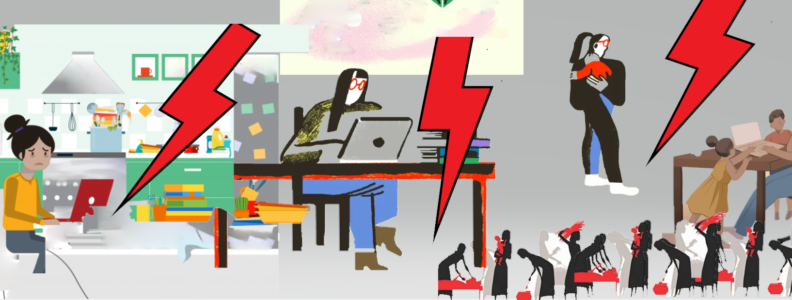In English
Desde el 2017, el 8 de marzo—el día internacional de la mujer trabajadora—se ha conmemorado con potentes huelgas feministas, que inventan nuevas prácticas y geografías de la huelga, haciendo paro tanto en trabajos (mal)pagados como en el trabajo doméstico y de cuidado no remunerado, rechazando los mandatos de género que distribuyen las tareas de forma desigual y que nos quieren dictaminar nuestro papel y potencial. A su vez, la huelga produce un tiempo de encuentro, para encontrarnos y elaborar nuevas formas de estar juntes, tejiendo nuevas alianzas y conexiones entre distintas luchas.
Sin embargo, la pandemia, y la consecuente crisis económica social, conlleva un conjunto de nuevas dificultades a la hora de parar. Ya sabemos que la pandemia afecta a las mujeres de forma más intensa. Ya sea en las primeras líneas de los hospitales y centros de salud, o en trabajos llamados esenciales sumamente feminizados y mal pagados, de la educación o el cuidado, o encerradas en el espacio doméstico por la cuarentena, convirtiéndonos en maestra, cuidadora, cocinera, todo a la vez y por tiempo completo, somos las mujeres que estamos poniendo los cuerpos contra la virus y la crisis.
Entonces, como paramos en el medio de una pandemia?
A partir de nuestra llamada a realizar mapas-derivas de la cuarentena, proponemos este ejercicio de mapeo como un método para repensar y rehacer tu/nuestra huelga. Se puede hacer sola o con grupos de amigues y compañeres, se puede dibujar sobre papel en blanco, o sobre un mapa base, hacer un collage o un diagrama del uso de tiempo, usar íconos o pegatinas. Los resultados se pueden compartir con nosotres (countercartographies(@)gmail.com) y en sus propias redes.
* Dibuja un mapa de tu vida cotidiana: ¿A dónde vas? ¿Dónde/cuándo trabajas? Trabajo remunerado, no remunerado, mal remunerado, etc. ¿Cómo (y quién) extrae valor de tu vida cotidiana? ¿Cuándo, y dónde, no trabajas?
* Mapea tus redes: ¿En qué redes de cuidado estás sumergida? ¿Quiénes trabajan para sostener tu cuarentena? ¿Y tu trabajo, a qué cuarentenas sostiene?
*¿Cuál es tu huelga? Mirando tu mapa de todo tu trabajo, ¿cómo vas a parar? ¿Dónde y cuándo vas a parar?
* ¿Qué hace falta para hacer posible tu huelga? Sabemos que no se puede parar sola. Sabemos que el trabajo de cuidado que hacemos en necesario en términos vitales, y, sin embargo, tenemos que parar. ¿Puedes imaginar un mapa de las conexiones, los apoyos, las infraestructuras, que harían posible tu huelga?

